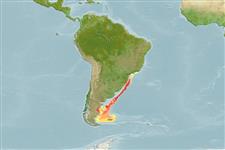ইলাসমোব্রাঙ্কি (হাঙ্গর এবং রে) (sharks and rays) >
Squatiniformes (Angel sharks) >
Squatinidae (Angel sharks)
Etymology: Squatina: Latin for skate, which angel sharks superficially resemble, presumably tautonymous with Squalus squatina Linnaeus 1758 (no species mentioned) (See ETYFish); argentina: Presumably named for Argentina, described from off the coast of Buenos Aires (the province, not the city) (See ETYFish).
Environment: milieu / climate zone / গভীরতার পরিসীমা / distribution range
বাস্তুসংস্থান
সামুদ্রিক তলদেশ বিহারী; গভীরতার পরিসীমা 100 - 400 m (Ref. 57911). Subtropical; 19°S - 53°S, 68°W - 38°W (Ref. 54901)
Southwest Atlantic: Brazil to southern Uruguay.
আকৃতি / ওজন / Age
পরিপক্কতা : Lm ? range ? - 120 cm
Max length : 170 cm TL পুরুষ/ লিঙ্গ অনিধর্ারিত ; (Ref. 247); common length : 100.0 cm TL পুরুষ/ লিঙ্গ অনিধর্ারিত ; (Ref. 6077)
This species is distinguished from its congeners by having a darker background color, ranging from dark-brown to reddish-brown (vs. light-brown to dark-brown in S. guggenheim and S. occulta), with higher number of tooth rows with 24 vertical tooth rows in both upper and lower jaws, tooth formula 12-12/12-12; (vs. 9-9 to 10-10/9-9 to 11-11 in S. occulta, and 9-9 to 11-11/9-9 to 11-11 in S. guggenheim), and with anterior half of pectoral fin margin convex (vs. anterior margin of pectoral fin straight); differs from S. guggenheim and S. occulta with the interspiracular surface covered by small and homogeneous dorsal denticles, without enlarged denticles (vs. a pair of enlarged, conical and morphologically distinct dermal denticles between spiracles in S. occulta and S. guggenheim); differs from S. occulta by lacking blackish irregular small spots surrounding white spots on dorsal surface (i.e. absence of ocelli-like markings); differs further from S. guggenheim by having the dorsal midline denticles on trunk morphologically similar to other trunk denticles and barely organized in a row (vs. dorsal midline row of enlarged denticles morphologically distinct from other trunk denticles), the denticles close to origin of pectoral fin morphologically homogeneous, similar to other pectoral denticles (vs. presence of a pair, or more, enlarged and morphologically distinct denticles from other pectoral denticles, in S. guggenheim) (Ref. 95520).
Cross section: angular.
Found on the continental shelf and slope. Ovoviviparous (Ref. 50449).
Life cycle and mating behavior
পরিপক্কতা | প্রজনন | ডিম ছাড়া | ডিমসমূহ | ডিম্বধারন ক্ষমতা | শুককীট
Ovoviviparous, embryos feed solely on yolk (Ref. 50449). Both ovaries are functional (Ref. 57911).
Vaz, D.F.B. and M.R. De Carvalho, 2013. Morphological and taxonomic revision of species of Squatina from the Southwestern Atlantic Ocean (Chondrichthyes: Squatiniformes: Squatinidae). Zootaxa 3695(1):001-081. (Ref. 95520)
IUCN Red List Status (Ref. 130435: Version 2025-1)
Threat to humans
Traumatogenic
Human uses
মৎস্য: মৎস্যচাষের অস্তিত্ব
হাতিয়ার
Special reports
Download XML
ইন্টারনেট সুত্র
Estimates based on models
Preferred temperature (সূত্র
123201): 4 - 16.3, mean 6.1 °C (based on 18 cells).
Phylogenetic diversity index (সূত্র
82804): PD
50 = 0.5000 [Uniqueness, from 0.5 = low to 2.0 = high].
Bayesian length-weight: a=0.00676 (0.00295 - 0.01551), b=3.07 (2.88 - 3.26), in cm total length, based on LWR estimates for this Genus-body shape (Ref.
93245).
ট্রফিক পর্যায়ে (সূত্র
69278): 4.1 ±0.6 se; based on diet studies.
স্থিতিস্থাপক (সূত্র
120179): অত্যন্ত কম , সর্বনিম্ন প্রজন দ্বিগুনের সময় ১৪ বৎসর (Fec 7-11).
Fishing Vulnerability (Ref.
59153): Very high vulnerability (90 of 100).
🛈
Climate Vulnerability (Ref.
125649): High to very high vulnerability (71 of 100).
🛈
Nutrients (Ref.
124155): Calcium = 8.08 [1.10, 152.92] mg/100g; Iron = 0.689 [0.065, 8.563] mg/100g; Protein = 18.4 [16.3, 20.6] %; Omega3 = 0.288 [0.108, 0.796] g/100g; Selenium = 34.1 [6.7, 171.6] μg/100g; VitaminA = 5.73 [0.45, 68.92] μg/100g; Zinc = 0.355 [0.021, 4.093] mg/100g (wet weight);
